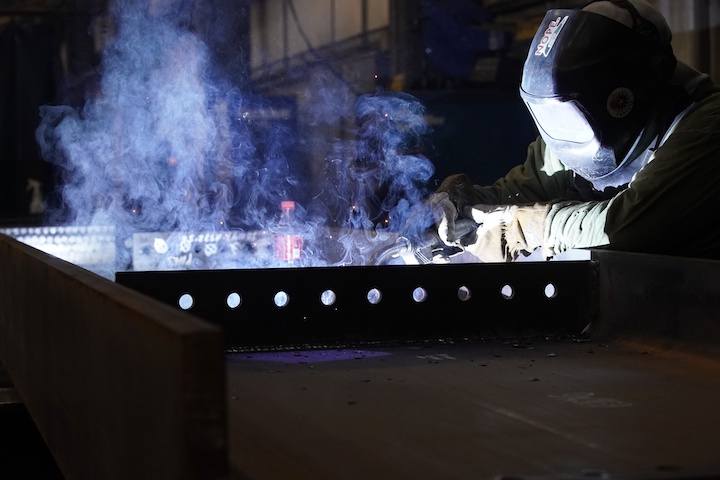Arguably the biggest beneficiaries of U.S. President Joe Biden’s plan to spend $620 billion on highways, roads and bridges are the steelmakers.
The Brazilian ones, that is. And the Korean ones. And the Vietnamese and Taiwanese ones. But not so much the once-mighty American steelmakers that Biden — and Donald Trump before him — pledged to revive.
American steel is too expensive for that — $300 a ton more expensive, based on estimates from Bloomberg and Kallanish Commodities. So expensive that two ships hauled thousands of tons of steel coils from Vietnam and Taiwan to the port of Houston last week, while U.S. Steel Corp.‘s Big River Steel complex — a mere 10-hour drive from the port — makes the exact same coil.
“Shipments are booked, chartered and rolling,” Anton Posner, chief executive officer of supply-chain engagement and consulting company Mercury Resources, said in a phone interview. “We’re seeing a pickup on steel shipments from Southeast Asia, and it’s all demand driven.”

There’s no question Biden’s stimulus will boost U.S. growth. In anticipation of the package, the Paris-based Organization for Economic Cooperation and Development earlier this month more than doubled its 2021 growth forecast for the U.S. to 6.5%.It’s just not clear how effective it will be in helping the Rust Belt in a way that would benefit millions of Americans who’ve for years felt left out of the country’s growing prosperity. Roughly 110,000 steelworkers have lost their livelihoods since 1990, with a nearly 7% drop in steel jobs since the pandemic started. The United Steelworkers said after Biden’s announcement that large-scale investment in infrastructure has been “long overdue,” and that aggressive investment coupled with strong “Buy America” provisions would provide a secure economic base for generations to come.Tom Conway, president of the United Steelworkers, said “companies now will have the horizon and certainly they’ll need to build out domestic capacity and invest in America’s future.” But when it comes to new jobs, he admits “it’s tricky.”
In Pittsburgh, where Biden announced his stimulus plan on Wednesday, U.S. Steel has no plans to bring back furnaces idled during the height of the pandemic or hire more workers, even though the industry has long known the spending package was coming. When asked whether the company was willing to bring on new capacity, ramp up output or re-open facilities, U.S. Steel spokeswoman Amanda Malkowski said the company supports infrastructure investment for benefit of America, “but we’re not going to speculate beyond that.”Nucor Corp., the largest U.S. steelmaker, said it’s slated to expand capacity at its Gallatin mill in Kentucky later this year, and will begin operating a new steel plate mill in 2022. But CEO Leon Topalian says the company is ready and able to handle any new infrastruture coming online. Cleveland-Cliffs Inc. and Steel Dynamics Inc., two more of the biggest producers, didn’t respond to similar requests.Meanwhile, Coilplus Inc., a steel processor in Rosemont, Illinois, is having to buy foreign steel because the domestic mills simply can’t produce enough, Chief Operating Officer Jim Lehr said. The steelmakers have told him some products are sold out through next year, meaning he needs to find tons elsewhere for the next two years, right when infrastructure projects would begin coming online.
As part of his $2.25 trillion infrastructure program, Biden also wants to commit $300 billion to boost manufacturing industries that have urged his government to scrap tariffs on foreign steel.The price of a short ton of U.S.-made hot-rolled coil steel is more than $1,300, whereas the cost to import it including tariffs and transportation fees is about $1,000 a ton. The difference is the largest premium for American steel since Trump implemented Section 232 tariffs to protect the industry in the name of national security.“The whole deal with Section 232 is that the mills pledged: ‘If you protect us from imports, we will be sufficient to supply the market,’ but the fact is they were not ready when they should’ve been, when the market came back,” said Timna Tanners, an analyst at Bank of America. “This whole argument of a level playing field doesn’t really ring so true anymore when the U.S. price is easily $300-plus more than the rest of the world.”
Biden, steel executives and steelworkers want provisions that would require any of the federal-sponsored stimulus programs to use a high percentage of U.S.-made steel, which would in theory help get people back to work. But American steelmakers show no signs of adding employees. After being hard-hit by the pandemic, they don’t want to risk ramping up production only to have to incur the sky-high costs of shutting down blast furnaces all over again down the road.
To be sure, lead times for imported materials are about four to five months, meaning it will take customers a long time before shipments they order today to finally arrive. Steel executives also say that, with big infrastructure projects, the industry won’t receive new orders until 2022 at the earliest as it takes several years for designs and permitting to occur. And if they’re shovel-ready jobs — meaning you can recall workers to make minor fixes to existing infrastructure — those don’t require significant enough steel demand to move the needle.
U.S. steel consumption will be about 104 million tons this year and about 108 million tons in 2022, outpacing supplies of 87 million and 91 million tons, respectively, from American steelmakers in the next two years, according to Bloomberg Intelligence analyst Andrew Cosgrove. “If you want to revive U.S. manufacturing, you need to make sure there’s sufficient supply here,” Bank of America’s Tanners said.

Follow us on social media: